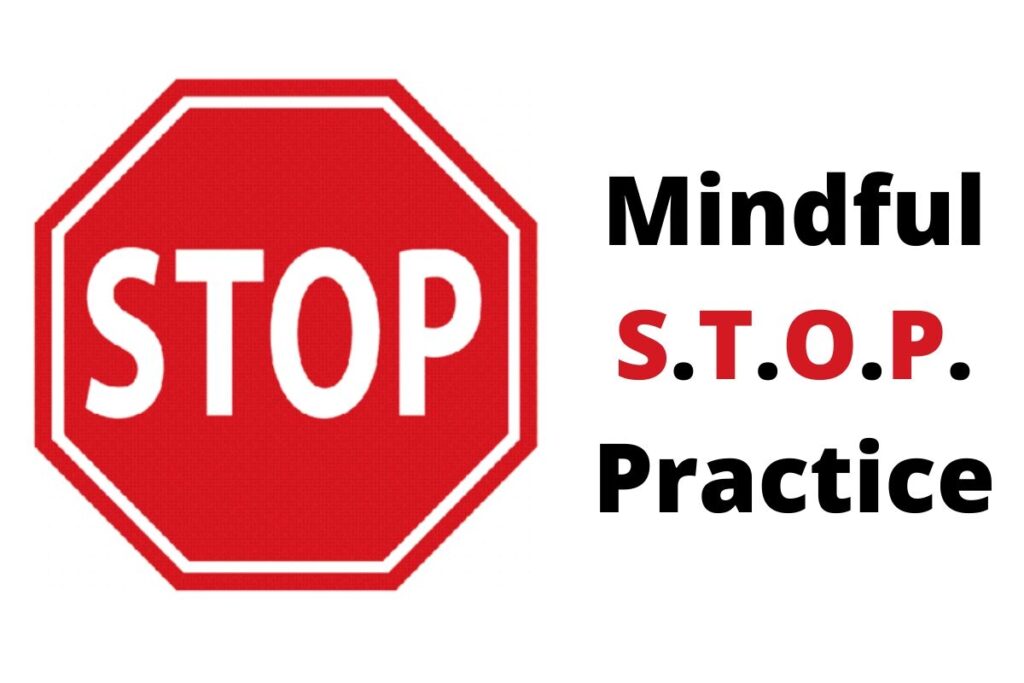Stress can drain our mental resources, and during challenging times we can end up stuck in our habitual patterns of reacting. Because of such repeated patterns of responding, we might, at times, react mindlessly to situations presenting themselves. This might not be a skilful way to deal with situations that require us to stop and take stock of what present before proceeding forward. This is where the mindful STOP practice could be of help as it can help in pausing and grounding to take better stock of whatever is presenting itself to us. The mindful STOP practice can be a means through which we pause so that to try to respond skillfully, instead of reacting mindlessly.
What is the mindful STOP practice
The mindful STOP practice is a simple mindfulness technique that reminds us to pause and take a breath to check in with ourselves to see how we are doing. It can assist us in shifting from our habitual states of distraction and automatic pilot to being present with intention in whatever we are doing.
What’s the mindful STOP practice used for
The STOP practice is used to help us pause and introduce moments of mindful experience throughout our day when you notice that your mind is all over the place.
Sometimes after experiencing a good meditation practice, we might feel grounded and present with experience. Although after a while it is quite easy to get lost up again in the hustle and bustle of everyday life running on automatic pilot. By using a mindful STOP periodically during our day, we can notice when our mind is lost in autopilot pilot, and bring it back to whatever we are doing right now at the moment. Let it be having a coffee, relaxing on the beach, enjoying time with our family, watching a movie or simply sitting down trying to relax on a couch.
Points to remember when doing a mindful STOP
When practising a mindful STOP a note of caution is warranted. This practice is more intended for persons who already have a regular stable daily formal meditation practice routine. Wolf and Serpa (2015) caution that beginners to meditation might find that this practice might not work for them until they are in a place where they find a sense of calm feel less reactive or an urge goes away.
It is also essential to keep in mind that the STOP technique is meant as a short practice for ground oneself in momentary experience to observe what is happening rather than reacting to whatever presents itself to us. Wolf and Serpa (2015) point out that during a mindful STOP practice:
“Sometimes, you may notice that the sensations in the body, your thoughts, or your emotions have changed, and sometimes you might notice that they haven’t changed at all. You are still doing it just right. The goal is to notice, not to change your experience.” p. 128
What does STOP stand for
S.T.O.P. is an acronym that stands for:
S — Stop, or pause
T — Take a breath
O — Observe the body, thoughts, feelings, emotions, and physical sensations
P — Proceed with more awareness
Following is a script from Wolf and Serpa (2015, p. 128) of the mindful STOP practice:
- S–Stop for just a moment. Don’t react. Give yourself the gift of brief reflection.
- T–Take a breath. Breathe in and out. Track your breath. Sense the chest rising and falling.
- O–Observe your experience. Notice the sensations in the body. Observe the thoughts or the story going through your mind, and appreciate that thoughts are not facts. Explore your emotions and get a sense of where you are in this moment.
- P–Proceed. Move forward in a way that feels right to you and is consistent with your values.
Following is a guided STOP practice by Elisha Goldstein, one of the authors of a mindfulness-based stress reduction workbook.
Guided STOP practice by Elisha Goldstein
When can you do a Mindful STOP practice
You can do the STOP practice at any time throughout your day. Stahl and Goldstein (2019) suggest choosing various times during your day where you might fit such exercise to periodically check in with oneself – a few seconds to a minute is all you need. For example, while brewing a coffee or tea, before your children come home from school, while waiting in a queue or whenever you notice you have a moment were you just there with nothing else to do.
Stahl and Goldstein (2019) comment that through their experience teaching the STOP mindfulness practice, they came across people who find it helpful to schedule pop-up reminders on their smartphones or computers for example once every hour. They suggest that it is best to be creative and find different ways which you see suite you well as a prompt to STOP and come back into the moment.
Using the STOP practice as a reminder to pause and take stock of what you are experiencing during various times in your day, can help increase our awareness of what is going on in and around you. You might notice that you engage in sprees of negative thinking, and this practice might help put a stop to that. Or sometimes using STOP may help you notice when your body is becoming tense, where you might notice that you are hungry and that a break might be helpful.
Mindful STOP Practice Infographic

All material provided on this website are for general informational purposes only read our disclaimer.
References
Stahl, B., & Goldstein, E. (2019). A mindfulness-based stress reduction workbook (2nd ed.). Ockland, CA: New Harbinger Publications.
Wolf, C., & Serpa, J. G. (2015). A clinician’s guide to teaching mindfulness: The comprehensive session-by-session program for mental health professionals and healthcare providers. Oakland, CA: New Harbinger Publications.

